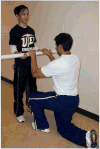Effects of manual resistance training on fitness in adolescents
- PMID: 19826296
- PMCID: PMC2907740
- DOI: 10.1519/JSC.0b013e3181b8d42a
Effects of manual resistance training on fitness in adolescents
Abstract
Manual resistance training (MRT), an alternative to traditional resistance training, requires minimal equipment and may be effective when applied in school-based physical education (PE) classes. The purpose of this study was to document the physical changes in adolescents (n = 222) using MRT in school-based PE settings. Six fitness tests from the Fitnessgram assessment tool were selected to assess students' cardiovascular and muscular fitness, and skinfold tests were used to assess body composition. One control and 2 experimental groups were defined. The control group of students (n = 129) attended regular PE classes. One experimental group (n = 63) attended PE that was complemented by the MRT system. A second experimental group (n = 30) attended PE complemented by MRT and cardiovascular endurance training. With use of the selected Fitnessgram tests, post-test measurements were performed after 9 and 18 weeks of PE. At baseline, there were no significant differences among the 3 groups for most measures. Compared with baseline, the experimental groups improved significantly in all 6 fitness measures and showed more improvements than the control group in most fitness measures both at 9 and 18 weeks. None of the groups showed significant improvement in body composition. The results documented that an MRT-complemented PE program was effective in improving adolescents' muscular fitness. An 18-week combined MRT and cardiovascular endurance training program effectively improved cardiovascular and muscular fitness but was ineffective in improving adolescent body composition. An MRT-based exercise session requires minimal equipment and set-up and can be performed in a short period of time, and therefore it is suitable for application in regular PE settings.
Figures
References
-
- Andersen RE, Crespo CJ, Bartlett SJ, Cheskin LJ, Pratt M. Relationship of physical activity and television watching with body weight and level of fatness among children: results from the Third National Health and Nutrition Examination Survey. JAMA. 1998;279:938–942. - PubMed
-
- Centers for Disease Control and Prevention. Physical activity levels among children aged 9–13 years—United States, 2002. Morbidity and Mortality Weekly Report. 2003;52:785–788. - PubMed
-
- Coleman KJ, Heath EM, Alcala IS. Overweight and aerobic fitness in children in the United States/Mexico border region. Rev Panam Salud Publica. 2004;15:262–271. - PubMed
-
- Committee on Progress in Preventing Childhood Obesity. Progress in Preventing Childhood Obesity: How Do We Measure Up? Washington, D.C.: Institute of Medicine of the National Academies: National Academies Press; 2007. p. 476.
-
- Crespo CJ, Arbesman J. Obesity in the United States. Phys Sportsmed. 2003;31:23–29. - PubMed


